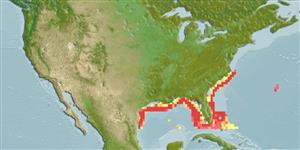Environment: milieu / climate zone / depth range / distribution range
Ekologi
marina bottenlevande; djupintervall 37 - 300 m (Ref. 5217), usually 73 - 180 m (Ref. 7251). Subtropical; 37°N - 24°N
Western Atlantic: North Carolina and northern Gulf of Mexico to southern Florida in USA; northern coast of South America (Ref. 5217).
Size / Vikt / Age
Maturity: Lm ? range ? - ? cm
Max length : 17.5 cm TL hane/ej könsbestämd; (Ref. 7251)
Taggstrålar i ryggfenan (totalt) : 9 - 10; Mjukstrålar i ryggfenan (totalt) : 12 - 13; Taggstrålar i analfenan: 0; Mjukstrålar i analfenan: 11.
Inhabits offshore waters, mostly from 73-180 m depth. Minimum depth from Ref. 26912.
Life cycle and mating behavior
Maturities | Reproduktion | Spawnings | Egg(s) | Fecundities | Larver
Robins, C.R. and G.C. Ray, 1986. A field guide to Atlantic coast fishes of North America. Houghton Mifflin Company, Boston, U.S.A. 354 p. (Ref. 7251)
IUCN Red List Status (Ref. 130435)
Threat to humans
Harmless
Human uses
Verktyg
Special reports
Download XML
Internet-källor
Estimates based on models
Preferred temperature (Ref.
123201): 17.8 - 23.9, mean 20.5 °C (based on 30 cells).
Phylogenetic diversity index (Ref.
82804): PD
50 = 0.5000 [Uniqueness, from 0.5 = low to 2.0 = high].
Bayesian length-weight: a=0.00525 (0.00220 - 0.01254), b=3.13 (2.92 - 3.34), in cm total length, based on LWR estimates for this (Sub)family-body shape (Ref.
93245).
Trofisk nivå (Ref.
69278): 3.5 ±0.5 se; based on size and trophs of closest relatives
Resiliens (Ref.
120179): Hög, lägsta populationsfördubblingstid mindre än 15 månader (Preliminary K or Fecundity.).
Fishing Vulnerability (Ref.
59153): Low vulnerability (10 of 100).
